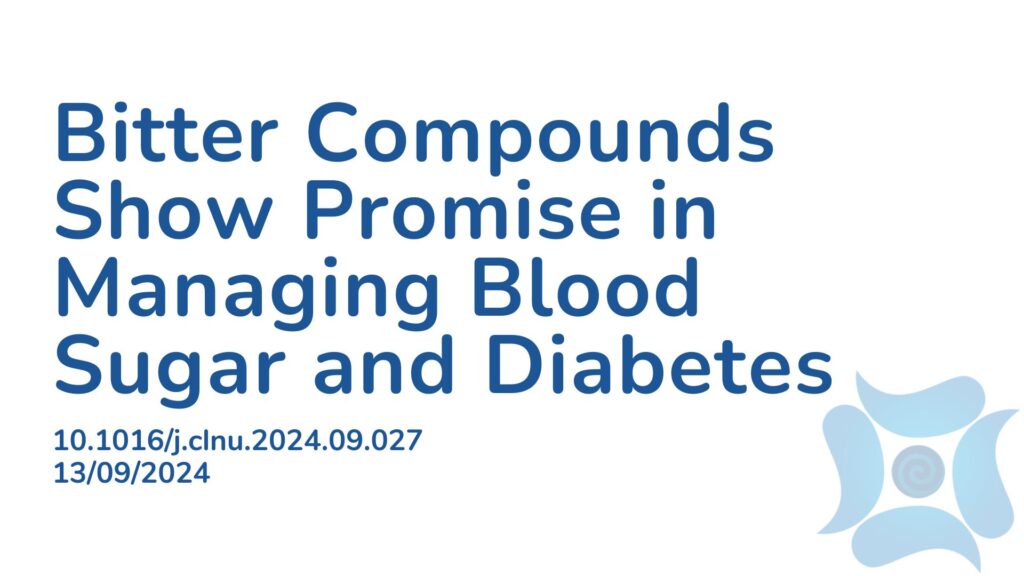Summary:
Bitter compounds can be found naturally in plants (like caffeine in coffee), or they can form during food processing (such as epigallocatechin gallate from green tea). There are also synthetic bitter compounds like hydroxychloroquine. These compounds vary in their structure, but most of them are detected by one or more of the 25 types of bitter taste receptors in the body, known as taste 2 receptors (TAS2Rs). Research suggests that when TAS2Rs in the gastrointestinal (GI) tract are activated by bitter compounds, it affects blood sugar levels. For example, a study found that when a TAS2R didn’t activate properly, it led to issues with blood glucose and insulin levels. The mechanism is thought to be TAS2Rs in certain GI cells triggering a chain reaction that leads to hormone release responsible for managing blood sugar levels. These findings are important for people with high blood sugar or type 2 diabetes, as high blood sugar over time increases the risk of heart disease and other complications. Therefore, using bitter compounds to manage blood sugar could potentially help prevent and treat these conditions. Previous studies have shown that caffeine and catechins from green tea may also lower fasting blood glucose, but only looked at individual bitter compounds taken orally. The purpose of this review was to analyse randomized controlled trials (RCTs) that compared bitter compounds with placebos to see how they affected blood glucose levels two hours after a meal, the total blood sugar response over time, insulin levels, and c-peptide levels, which indicate how much insulin the body is producing. Forty-six studies were found, with 29 studies looking at long-term interventions and 17 examining short-term interventions. The long-term interventions reduced blood sugar levels at the two-hour mark, but did not affect the overall blood sugar or insulin levels. The short-term interventions did not significantly improve post-meal blood sugar, but subgroup analysis showed a reduction in overall blood sugar response after taking quinine family compounds. The authors concluded that long-term use of bitter compounds, especially those from the quinine family, may have potential benefits for people with blood sugar regulation issues. Short-term quinine use may also improve post-meal blood sugar levels. However, the quality of the current evidence is very low, so more studies with stronger methods are needed.
Abstract:
Background & aims: The post-oral sensing of bitter compounds by a family of bitter taste receptors (TAS2Rs) is suggested to regulate postprandial glycemia in humans. However, reports are inconsistent. This systematic review used meta-analysis to synthesise the impact of bitter compound interventions on the postprandial glycaemic response in humans. Methods: Electronic databases (Medline, PubMed, and Web of Science) were systematically searched from inception to April 2024 to identify randomised controlled trials reporting the effect of interventions utilising post-oral bitter compounds vs. placebo on postprandial plasma glucose levels at t = 2 h (2 h-PPG), and area under the curve (AUC) of glucose, insulin, and c-peptide. The random-effect and subgroup analysis were performed to calculate pooled weighted mean differences (WMD), overall and by predefined criteria. Results: Forty-six studies (within 34 articles) were identified; 29 and 17 studies described chronic and acute interventions, respectively. The chronic interventions reduced 2 h-PPG (n = 21, WMD = −0.35 mmol/L, 95%CIs = −0.58, −0.11) but not AUC for glucose or insulin. Subgroup analysis showed the former was particularly evident in individuals with impaired glycemia, interventions longer than three months, or quinine family administration. The acute interventions did not improve the postprandial glycemia response, but subgroup analysis revealed a decrease in AUC-glucose after quinine family administration (n = 4 WMD = −90.40 (nmol × time/L), 95%CIs = −132.70, −48.10). Conclusion: Chronic bitter compound interventions, particularly those from the quinine family, may have therapeutic potential in those with glycemia dysregulation. Acute intervention of the quinine family may also improve postprandial glucose. Given the very low quality of the evidence, further investigations with more rigorous methods are still required.
Article Publication Date: 13/09/2024
DOI: 10.1016/j.clnu.2024.09.027



